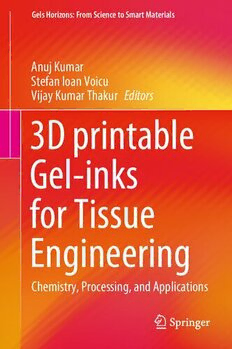Table Of ContentGels Horizons: From Science to Smart Materials
Anuj Kumar
Stefan Ioan Voicu
Vijay Kumar Thakur Editors
3D printable
Gel-inks
for Tissue
Engineering
Chemistry, Processing, and Applications
Gels Horizons: From Science to Smart
Materials
SeriesEditor
VijayKumarThakur,SchoolofAerospace,TransportandManufacturing,
CranfieldUniversity,Cranfield,Bedfordshire,UK
This series aims at providing a comprehensive collection of works on the recent
advances and developments in the domain of Gels, particularly as applied to the
various research fields of sciences and engineering disciplines. It covers a broad
range of topics related to Gels ranging from Polymer Gels, Protein Gels,
Self-HealingGels,ColloidalGels,Composites/NanocompositesGels,Organogels,
Aerogels,Metallogels&HydrogelstoMicro/Nanogels.Theseriesprovidestimely
anddetailedinformationonadvancedsynthesismethods,characterizationandtheir
application in a broad range of interrelated fields such as chemistry, physics,
polymer science & engineering, biomedical & biochemical engineering, chemical
engineering, molecular biology, mechanical engineering and materials science &
engineering.
This Series accepts both edited and authored works, including textbooks,
monographs,referenceworks,andprofessionalbooks.Thebooksinthisserieswill
provide a deep insight into the state-of-art of Gels and serve researchers and
professionals,practitioners,andstudentsalike.
Moreinformationaboutthisseriesathttp://www.springer.com/series/15205
· ·
Anuj Kumar Stefan Ioan Voicu
Vijay Kumar Thakur
Editors
3D printable Gel-inks
for Tissue Engineering
Chemistry, Processing, and Applications
Editors
AnujKumar StefanIoanVoicu
SchoolofChemicalEngineering FacultyofAppliedChemistry
YeungnamUniversity andMaterialsScience
Gyeongsan,Korea(Republicof) PolytechnicUniversityofBucharest
Bucharest,Romania
VijayKumarThakur
BiorefiningandAdvancedMaterials
Scotland’sRuralCollege
Dumfries,UK
ISSN2367-0061 ISSN2367-007X (electronic)
GelsHorizons:FromSciencetoSmartMaterials
ISBN978-981-16-4666-9 ISBN978-981-16-4667-6 (eBook)
https://doi.org/10.1007/978-981-16-4667-6
©TheEditor(s)(ifapplicable)andTheAuthor(s),underexclusivelicensetoSpringerNature
SingaporePteLtd.2021
Thisworkissubjecttocopyright.AllrightsaresolelyandexclusivelylicensedbythePublisher,whether
thewholeorpartofthematerialisconcerned,specificallytherightsoftranslation,reprinting,reuse
ofillustrations,recitation,broadcasting,reproductiononmicrofilmsorinanyotherphysicalway,and
transmissionorinformationstorageandretrieval,electronicadaptation,computersoftware,orbysimilar
ordissimilarmethodologynowknownorhereafterdeveloped.
Theuseofgeneraldescriptivenames,registerednames,trademarks,servicemarks,etc.inthispublication
doesnotimply,evenintheabsenceofaspecificstatement,thatsuchnamesareexemptfromtherelevant
protectivelawsandregulationsandthereforefreeforgeneraluse.
Thepublisher,theauthorsandtheeditorsaresafetoassumethattheadviceandinformationinthisbook
arebelievedtobetrueandaccurateatthedateofpublication.Neitherthepublishernortheauthorsor
theeditorsgiveawarranty,expressedorimplied,withrespecttothematerialcontainedhereinorforany
errorsoromissionsthatmayhavebeenmade.Thepublisherremainsneutralwithregardtojurisdictional
claimsinpublishedmapsandinstitutionalaffiliations.
ThisSpringerimprintispublishedbytheregisteredcompanySpringerNatureSingaporePteLtd.
The registered company address is: 152 Beach Road, #21-01/04 Gateway East, Singapore 189721,
Singapore
Preface
Overthepastdecade,additivemanufacturingtechnologieshaveemergedasoneofthe
mostwonderfulfabricationmethodsinthefieldoftissueengineeringandregenerative
medicineduetotheirprecisecontroland3Dprintingofarchitecturesaspertissue-
specificororgan-specificdemandsusingdigitalmodelsbasedonmedicalimaging
data. Among them, extrusion-based three-dimensional (3D) printing/bioprinting is
a commonly used technique in tissue engineering areas. Various gel-inks or bio-
inks have been developed and utilized for 3D printing by including natural and
syntheticpolymers,bioceramics,bioactiveglasses,andglass-ceramics.Significant
research has been performed in this area, but several challenges are remaining
to be overcome in terms of data imaging, additive manufacturing technique, and
designofbiomaterial-inks(i.e.gel-inksorbio-inks)withtheirgoodprintabilityand
post-printing shape fidelity, 3D printing of curved and complex architectures, etc.
Therefore, it is very important to understand the significance of 3D printing tech-
niques, especially in tissue engineering applications, where healthcare issues are
majorconcernsforhumanbeings.Aconciseunderstandingandanoverviewofthe
chemistryandprocessingofbiomaterialsand3Dprintingmethodsforvarioustissue
engineeringapplicationsareprovidedinthisbookforthereaders.Valuableknowl-
edgeisupdatedandorganizedaccordingtovariouscurrentstudiesworldwideinthe
fieldoftissueengineering.
This book provides an overview and discusses the chemistry, processing, and
tissueengineeringapplicationsofthebiomaterialsthathavebeenusedforsynthe-
sizing3D-printablegel-inks.Thisauthoritativebookprovidesthenecessaryfunda-
mentals and background for researchers and research professionals who intend to
workinthefieldof3Dbioprintingintissueengineering.In3Dbioprinting,thedesign
anddevelopmentofthebiomaterial-inks/bio-inksisamajorchallengeinproviding
a3Dmicroenvironmentspecificallytotheanatomicalandarchitecturaldemandof
nativetissues.Therefore,themainpurposeofthisbookistoprovidethebasicchem-
istryofthebiomaterials,theircurrentprocessingdevelopmentsandchallenges,and
recentadvancementsintissue-specific3Dprinting/bioprinting.Thetopicscomprise
mainly(1)biomaterialtypes,theirsynthesisand/ormodifications,andprocessingfor
theparticular3Dprintingmethod,(2)characterizationmethodsbeforeprintingand
v
vi Preface
post-printingaswellasinvitroandinvivoanalyses,and(3)theirapplicationsand
usesinvarioustissueengineeringapplications.Thisbookservesasago-toreference
on bioprinting and is ideal for students, researchers, and professionals, including
thoseinacademia,government,themedicalindustry,andhealthcare.
Chapter 1 provides the introduction to 3D printing technology for biomedical
applications, describing the progress and development of printing technology to
create organs or tissues including limitations. Chapter 2 presents the characteriza-
tionofbio-inksfor3Dprintingapplicationsbyexplainingnumerouscharacterization
methods.Chapter3discussesthe3Dprintingofhydrogelconstructstowardtargeted
development in tissue engineering. Chapter 4 presents and discusses 3D-printable
self-healingscaffoldsfortissueengineeringapplications.Chapter5focusesongel-
inks for 3D printing in corneal tissue engineering applications. Chapter 6 intro-
ducesthecurrentstateof3D-printablegel-inksutilizedforskinwoundtreatments,
whereasChap.7presentsbiofunctionalinksfor3Dprintinginskintissueengineering
applications. Chapter 8 explores the possibilities of using starch gels combined
with different bioceramics for additive manufacturing and alternative fabrication
methods for developing biomimetic implants for filling large bone defects, while
Chap.9focusesonadditivemanufacturingofbioceramicscaffoldsforbonetissue
engineeringapplicationsbyemphasizingstereolithographicprocessing.Chapter10
is concerned with 3D-printable gel-inks for microbes and microbial structures to
study microbes and microbe-host interactions, biofilm formation, antibiotic resis-
tance,andmicrobiomethrough3Dmodelingofmicrobesandinfectionsforunder-
standingdiseasesinabroadersense.Chapter11describesthemethodsofpolysaccha-
ridecrosslinking,specificallyfuturecrosslinkingmethodsofalginatehydrogelsfor
3Dprintingforbiomedicalapplications,includingtissueengineeringareas.Lastly,
Chap. 12 discusses the future perspectives for gel-inks for 3D printing in tissue
engineeringbyconsideringprecursorsandotherspecificchallenges.
Atlast,butmostimportantly,wewouldliketothankandacknowledgetheauthors
who contributed to this book. In addition, we thank all reviewers for giving their
valuabletimetoprovidetheirreviewstimelytoimprovethequalityofthisbook.
Gyeongsan,SouthKorea AnujKumar
Bucharest,Romania StefanIoanVoicu
Dumfries,UK VijayKumarThakur
About This Book
1. Provides the background for 3D printing and tissue engineering and their
challenges.
2. Providesthechemistry,functionalization,andprocessingofbiomaterials.
3. Describes the pre-printing and post-printing processes for biomaterials
accordingtoparticular3Dprintingmethods.
4. Discussestheefficacyofgel-inksforvarioustissueengineeringapplications.
5. Discusses the futuristic perspective in terms of 3D, 4D, and 5D
printing/bioprintingtechnology.
vii
Contents
1 Introduction to 3D Printing Technology for Biomedical
Applications .................................................. 1
SatishKumar,RamarajuBendi,andVipinKumar
2 CharacterizationofBioinksfor3DBioprinting .................. 27
SayandeepSahaandPallabDatta
3 3D Printing of Hydrogel Constructs Toward Targeted
DevelopmentinTissueEngineering ............................. 79
AlexandraI.Cernencu
4 Three-Dimensional Self-healing Scaffolds for Tissue
EngineeringApplications ...................................... 129
DurgalakshmiDhinasekaran,MohanrajJagannathan,andAnujKumar
5 Gel-Inksfor3DPrintinginCornealTissueEngineering .......... 161
SongulUlag,SumeyyeCesur,EcemDogan,MustafaSengor,
NazmiEkren,CemBulentUstundag,andOguzhanGunduz
6 ThreeDimensional(3D)PrintableGel-InksforSkinTissue
Regeneration ................................................. 191
SiminNazarnezhad, SaraHooshmand, FrancescoBaino,
andSaeidKargozar
7 BiofunctionalInksfor3DPrintinginSkinTissueEngineering ..... 229
ElifIlhan, EsmaAhlatciogluOzerol, SaadetAlpdagtas,
MustafaSengor,CemBulentUstundag,andOguzhanGunduz
8 Bioceramic-StarchPasteDesignforAdditiveManufacturing
andAlternativeFabricationMethodsAppliedforDeveloping
BiomedicalScaffolds .......................................... 261
AndreeaMaidaniucandFlorinMiculescu
ix
x Contents
9 AdditiveManufacturingofBioceramicScaffoldsforBone
TissueRegenerationwithEmphasisonStereolithographic
Processing .................................................... 297
FrancescoBaino,ElisaFiume,GiuliaMagnaterra,andEnricaVerné
10 3DPrintableGel-InksforMicrobesandMicrobialStructures ..... 333
EcemSaygiliandMohamedS.Draz
11 MethodsofPolysaccharidesCrosslinking:Future-Promising
Crosslinking Techniques of Alginate Hydrogels for 3D
PrintinginBiomedicalApplications ............................. 355
RefatM.Hassan(El-Moushy)
12 FuturePerspectivesforGel-Inksfor3DPrintinginTissue
Engineering .................................................. 383
AnujKumar,VijayKumarThakur,andStefanIoanVoicu

